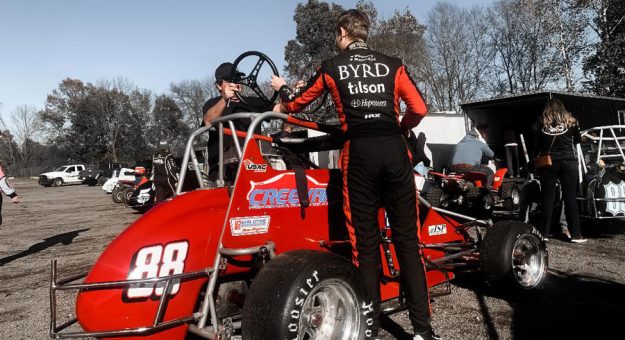Byrd Racing spent the April 8-9 weekend running the Focus midget at Dillon (S.C.) Motor Speedway before taking a much-anticipated weekend off to celebrate Easter.
I ran the Creevan Performance Focus midget with Mike Creevan. Entering the racing weekend, I wasn’t quite sure if any of my racing experience this season would translate to this car. After all, my racing experience this year has included prototype racing, dirt sprint car racing and multiple forms of formula car and sports car racing.
Recent success boosted the confidence level, but it was important to know if the skill level and abilities would translate into oval racing and competing at the highest level.
The weekend definitely answered that question.
The first day, we tested on old tires — the same set I ran at Havasu 95 Speedway from the second day of racing there. My crew played with the setup throughout the weekend, trying to dial it in and test changes to how it affected the car. My understanding of the car and the setup changes felt better than it was before.
By working with old tires, we didn’t want to come up with the ultimate setup as much as know that we were within the competitive realm for Dillon.
On Saturday, we continued to use old tires in practice before swapping over to our new tires. After we scuffed in the new tires in the second practice, it was time to qualify.
This was an important session because it gave me my first clue as to the car’s setup on new tires. The car felt fairly tight and it wasn’t letting me roll as much speed through the corner as I thought I needed to. We made an adjustment to loosen up the car for qualifying and it still didn’t feel like enough.
I qualified sixth, almost one full second off the speed set by pole qualifier Brady Allum. That felt like being five seconds off in the pace for a sports car race.
We needed to take a big swing at the setup to keep from losing pace. We came close to running out of the adjustment in the car when trying to loosen it up for qualifying.
Creevan, though, still had some tricks up his sleeve.
In the race, I was determined to take advantage of the traditional USAC inversion of the top-six qualifiers, which meant I would be starting on the pole.
After a false start from the driver starting beside me, the yellow flag came out to reset the grid. On the second start, I lost the lead before even taking the green flag.
So much for the reset.
Two more competitors from behind proceeded to pass me on the inside of turns three and four because I was unable to turn the car in and was loose off the corners.
After dropping back to fourth, I tried to get the car underneath Hunter Wise, who was pressuring me from behind, but lost the position to him a lap or so later.
At that point, the car was a handful and was quickly losing positions.
Fast-qualifier Brady Allum began to challenge me in turns three and four, but I was committed to not losing any more positions. Entering the first turn, Allum pulled down deep to pass me on the inside.
He lost control of his rear in mid-corner and the car slid up the track into mine. His right-rear flattened my left-rear tire and dented the left-side body panels. Also, I sustained a banged-up elbow.
Mike and a crew member from another team were helping to change my left-rear tire when Brady Allum’s dad walked up to me while I was in the car.
He threatened that if I ever did that (bleep) again, he’d clean my (bleeping) clock.
That was what I needed to hear after getting taken out by his son to reinvigorate my spirit and drive to the end of the race.
When I left the pits, seven laps down, all I wanted to do was finish the race with a better understanding of the car and competitive lap times.
The remaining laps, I became more comfortable with the car and began experimenting to understand the nuances to optimize the setup.
Because I practiced on old tires, the race was the first time I ran the new rubber.
I ended the race with my fastest lap, running a lap time on my final lap that was only four-tenths off the race winner’s fastest lap, which occurred in the first half of the race.
Frustrated that I couldn’t contend for the podium, I was also pleased that I was able to answer some questions.
Had my diverse experience racing other platforms of cars improved my ability to drive a completely different car in a completely different discipline I hadn’t touched for months?
The answer was yes, and I was happy that was the case.
This experience has definitely given me more confidence going into my future short-track races, where I will be racing in faster cars in more competitive fields. I look forward to seeing how my diverse racing schedule continues to help me develop as a more and more competent and capable racing driver.
